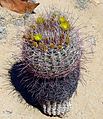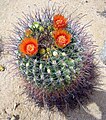Barrel cactus
This article needs additional citations for verification. (February 2015) |

Barrel cacti are various members of the two genera Echinocactus and Ferocactus, found in the deserts of Southwestern North America. Some of the largest specimens can be found in the Mojave Desert in southern California.
Description[]
Some species of barrel cactus reach over 1 metre (3.3 ft) in height at maturity, and have been known to reach 3 metres (9.8 ft) in some regions. The ribs are numerous and pronounced, and the spines are long and can range in color from yellow to tan to red, depending on the age of the plant and the species. Flowers appear at the top of the plant only after many years. The barrel cactus can live to be over 100 years old.
Barrel cactus buds typically start to bloom in April with a bright yellow or orange flower. Pink and red varieties also exist but occur less frequently. The flowers only appear on the very top of the plant. As the flowers begin to wilt in early May, they may change color. A late summer desert rainstorm can produce a late bloom, as shown in the photograph below of the orange-flowered variety (it bloomed two days after a hurricane in mid-August and continued to bloom through the end of September).
Fruit[]
As the flowers wilt away, small pineapple-shaped greenish fruit may form. Left untouched, the fruit has been known to last a full calendar year. The fruit can be easily removed but is not usually consumed because it is fairly dry and bitter.
Facts[]

Native Americans collected the fruit as emergency food during extreme drought conditions.
The Seri people distinguished three species of barrel cactus:[1]
- Saguaro barrel cactus — Ferocactus cylindraceus
- Siml caacöl (big barrel cactus), siml cöquicöt (killer barrel cactus) — Ferocactus emoryi
- Siml áa (true barrel cactus) — Ferocactus wislizeni
In Mexico the flesh of the barrel cactus is candied and eaten as a treat.
Cultivation[]
Barrel cactus are cultivated by plant nurseries as an ornamental plant. They are considered easy to grow and relatively fast growing. They may produce round offshoots.
Barrel cactus can fall over because they grow based on sun orientation. They usually grow towards the south to prevent surface tissue sunburn, giving the name "compass cactus."[2]
Gallery[]

Fishhook barrel cactus with fruit

Barrel cactus flowers

Field of barrel cacti, created with human intervention, in a gravel garden somewhere in California, US

Barrel cactus cluster in Sahuarita, Arizona
Barrel cactus at the Arizona-Sonora Desert Museum botanical garden

Blooming barrel cactus in the Mojave Desert, California

Late-blooming barrel cactus in Landers, California

Barrel cactus in Desert Botanical Garden, Phoenix, Arizona
References[]
- ^ Felger, Richard Stephen; Moser, Mary Beck (1985). People of the Desert and Sea: Ethnobotany of the Seri Indians. Tucson: University of Arizona Press. ISBN 978-0816508181.
- ^ Johnson, Mark (2003). The Ultimate Desert Handbook. McGraw-Hill Professional. p. 196. ISBN 978-0071393034.
- Cactoideae
- Cacti of Mexico
- Cacti of the United States
- North American desert flora
- Flora of the California desert regions
- Garden plants of North America
- Plant common names







